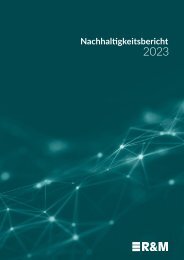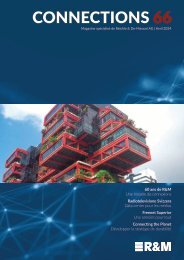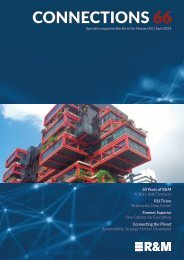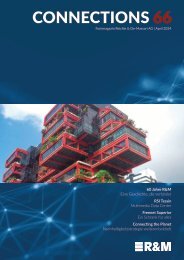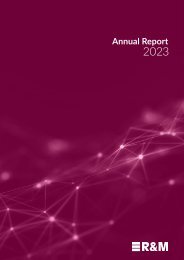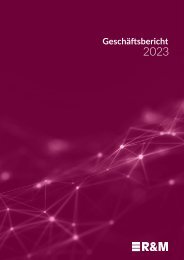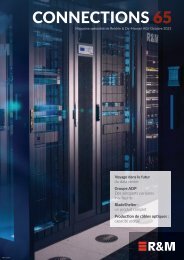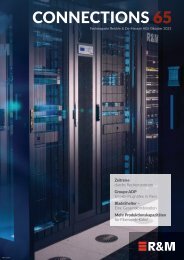CONNECTIONS_63-e
R&M specialist magazine CONNECTIONS no. 63
R&M specialist magazine CONNECTIONS no. 63
You also want an ePaper? Increase the reach of your titles
YUMPU automatically turns print PDFs into web optimized ePapers that Google loves.
to define different functions and integrate<br />
hardware and software. That requires greater<br />
attention to:<br />
030.7942<br />
– Interoperability<br />
– Integration<br />
– Standards (observing possible constraints<br />
caused by competing standards)<br />
– Monitoring (which can be done from a<br />
single dashboard)<br />
– Optimization (constantly manage the<br />
functions and bandwidth requirements of<br />
different services across many device types)<br />
today’s vast demand for bandwidth, 100G<br />
and 400G might be standard sooner than<br />
we imagine. Fiber allows DC operators to<br />
migrate to higher speeds relatively quickly<br />
and easily - this could not be achieved with<br />
copper cable infrastructure. Local networks<br />
can establish long-distance connections via a<br />
fiber backbone providing fast, high-capacity<br />
connectivity between DCs, edge DCs, and<br />
end users. Some DC operators are even<br />
developing their own optical point-to-point<br />
networks in order to realize cost savings<br />
while accommodating bandwidth growth and<br />
increasing flexibility.<br />
Besides wireless networks and (edge) DCs,<br />
other trends are driving the need for bandwidth,<br />
uptime, and therefore ubiquitous fiber:<br />
Internet of Things (IoT) which incorporates<br />
digital building management systems, All<br />
IP-networks, Digital Ceiling networks. According<br />
to Statista, the IoT will connect over<br />
75 billion devices by 2025.<br />
IP-based convergence enables the sharing<br />
of (virtualized) resources across applications<br />
and provides high levels of standardization,<br />
availability, reliability and support for new<br />
deployments. An ALL-IP approach extends<br />
the data network and PoE through an entire<br />
building’s ceiling, making it possible to<br />
connect devices to building automation via<br />
zones with pre-installed overhead connecting<br />
points. All areas of building automation can be<br />
integrated into a structured solution concept.<br />
Introduction of smart, converged networks<br />
means energy-conserving technologies and<br />
applications can be introduced, such as<br />
intelligent management of building space,<br />
resources and LED lighting.<br />
Smart cities and autonomous traffic will also<br />
enormously drive the need for fiber and<br />
convergence. Once 5G is widely available,<br />
people will use more streaming and remote<br />
working services on the go, as well as more<br />
060.2141<br />
virtual and augmented reality applications.<br />
Convergence offers greater flexibility, scalability,<br />
and uniformity. It allows users to make<br />
the most of increasingly sophisticated system<br />
intelligence. It provides enormous efficiency<br />
increases, from both technical and business<br />
perspectives, by centralizing management of<br />
IT resources, consolidating systems, boosting<br />
resource utilization rates and lowering costs.<br />
Deployment of converged networks helps<br />
reduce overall power consumption, improves<br />
cooling efficiency and enables introduction of<br />
further energy-saving measures.<br />
Understanding the networks’ needs<br />
Within a few years, every network will operate<br />
on the same combined fiber backbone.<br />
Data communication, mobile, video, and<br />
everything else will merge onto a coexisting<br />
network – which implies that we need to stop<br />
thinking in discrete networks.<br />
The benefits include reduced investments<br />
in rollout and maintenance, phasing out of<br />
legacy technologies, and a unified underlying<br />
technology and interfacing. Network operators<br />
and users can focus on their core business<br />
and develop applications that exactly<br />
match requirements, interact across systems<br />
and platforms, and are always up to date.<br />
However, one challenge springs to mind:<br />
Previously, we would use a separate device<br />
for each specific function, but now we need<br />
R&M products support the convergence<br />
development by allowing customers to design,<br />
build, test and deploy any functionality, based<br />
on fiber, with a single set of products and tools.<br />
We offer low, mid, and high density solutions,<br />
even completely preconfigured racks and data<br />
centers. We provide a complete package,<br />
including aerial, wireless, and wired solutions.<br />
The offering encompasses all hardware and<br />
software services as well as advice and consulting.<br />
Because top quality products are only<br />
half the solution: You need to fully understand<br />
the needs of every part of the network – and<br />
how different networks fit together – in order<br />
to provide the right solutions!<br />
Andreas Rüsseler | CMO<br />
andreas.ruesseler@rdm.com<br />
050.7086<br />
050.7276<br />
10|2022–<strong>63</strong> <strong>CONNECTIONS</strong> | 33







